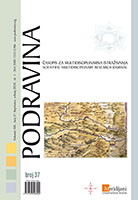- RAZMJERI RECENTNOG EGZODUSA IZ HRVATSKE – ANALIZA PODATAKA SLUŽBENIH STATISTIKA RH I ZEMALJA USELJAVANJA HRVATSKOG STANOVNIŠTVA
- PRVI POPIS OBRTNIKA I TRGOVACA (NAKON HRVATSKOUGARSKE NAGODBE) U ĐURĐEVAČKOM KOTARU 1890.
- LANDSCAPE TRANSFORMATIONS ON MOHÁCS ISLAND FOLLOWING RIVER REGULATIONS
- SPATIAL PERSPECTIVE OF STEREOTYPING TOWARDS ROMA
- ANALIZA PODUZETNIČKE INOVATIVNOSTI NA PODRUČJU SJEVERNE HRVATSKE ANALIZA PODUZETNIČKE INOVATIVNOSTI NA PODRUČJU SJEVERNE HRVATSKE
- UTJECAJ DIONIKA TRŽIŠTA NA IZVOZNA PODUZEĆA SJEVEROZAPADNE I SREDIŠNJE REGIJE REPUBLIKE HRVATSKE S OSVRTOM NA KOPRIVNIČKO – KRIŽEVAČKU ŽUPANIJU S ASPEKTA PRIHVAĆANJA I KORIŠTENJA NOVIH TEHNOLOGIJA
- ZUR HERKUNFT DER BÜRGER IN DEN STÄDTEN DES SLOWENISCHEN DRAU-GEBIETES IM 18. JAHRHUNDERT
- KLJUČEVI ŽIVOTA IVE KLUČKE. PROTUSLOVLJA SUDBINE UČITELJA I RATNIKA
- STJEPAN BLAŽETIN – KNJIŽEVNIK IZMEĐU DVIJU DOMOVINA I KNJIŽEVNOST HRVATA U MAĐARSKOJ
- ULOGA TERITORIJALNOG UPRAVLJANJA U PREKOGRANIČNOJ SURADNJI, NA PRIMJERU IPA PROGRAMA MAĐARSKA-HRVATSKA 2007.-2013.
- BUČAROVO VIĐENJE PROTESTANTIZMA I KATOLIČKE OBNOVE U SJEVERNOJ HRVATSKOJ
- STILSKO RESTAURIRANJE DVORA TRAKOŠĆAN SREDINOM 19. STOLJEĆA
- ŠTAJERSKI GRADOVI NA RIJECI DRAVI: PTUJ, MARIBOR I ORMOŽ NA GEOGRAFSKIM KARTAMA 16. STOLJEĆA
- PRIKAZI NOVIH KNJIGA, ČASOPISA I ZNANSTVENIH SKUPOVA
- UZ 70. GODIŠNJICU ŽIVOTA - MARIJAN ŠPOLJAR – KOPRIVNIČKI PISAC, KRITIČAR I »KULTURTREGER«
- IN MEMORIAM IVAN FUČEK, DI
LANDSCAPE TRANSFORMATIONS ON MOHÁCS ISLAND FOLLOWING RIVER REGULATIONS
Mohács (or formerly Margitta) Island is a river island of the Danube, located in the southern part of the Great Hungarian Plain, partly extending to Croatia. River regulations in the 19th century and related inland water drainage works reshaped the landscape pattern and farming systems of Mohács Island. First, second, and third military survey maps and a lesser known detailed survey, the so-called Danube mappation, were utilized for the reconstruction of the landscape in the 18th and 19th centuries. The scanned map-sheets were digitized and converted into a vector landscape map. These results were compared with a landscape map drawn on the basis of the 1952 topographic map. Our studies were supplemented with ethnographic data. As a result, we proved that the proportion of wetlands and riparian forests extremely reduced (Table 1, Fig. 8). At the same time, the rate of arable lands increased from zero to seventyone percent until the middle of the 20th century. Although, the process was not linear. By the end of the 19th century the island became very swampy which can be seen on our generated map from the third military survey (Fig. 6, Table , Fig. 8). Moreover, our maps present how many different riparian habitats were able to be found on the island and for how long. Finally, it can be stated which are the areas where inland water damage is expected and which are most suitable for arable cultivation.
Izvorni znanstveni rad / Original scientific paperAndrás HERVAI

